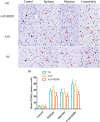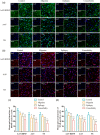Overexpression of BDNF in the ventrolateral periaqueductal gray regulates the behavior of epilepsy-migraine comorbid rats
- PMID: 35557046
- PMCID: PMC9226826
- DOI: 10.1002/brb3.2594
Overexpression of BDNF in the ventrolateral periaqueductal gray regulates the behavior of epilepsy-migraine comorbid rats
Abstract
Objective: To investigate the effects of brain-derived neurotrophic factor (BDNF) overexpression in the ventrolateral periaqueductal gray (vlPAG) on behavioral changes in epilepsy-migraine comorbid rats.
Method: We used an adeno-associated virus (AAV)-mediated vector to supplement BDNF in the vlPAG area prior to the establishment of a pilocarpine-nitroglycerin (Pilo-NTG) combination-induced comorbid model of epilepsy and migraine. Seizure- and migraine-related behaviors were analyzed. Cell loss and apoptosis in vlPAG were detected through hematoxylin-eosin (HE) and TUNEL staining. Immunofluorescence staining analyses were employed to detect expressions of BDNF and its receptor, tyrosine kinase B (TrkB), in vlPAG. Immunohistochemical staining was conducted to detect expressions of c-Fos and calcitonin gene-related peptide (CGRP) in the trigeminal nucleus caudalis (TNC) and trigeminal ganglion (TG).
Results: Comparing to control group, AAV-BDNF injected comorbid group showed lower pain sensitivity, scratching head, and spontaneous seizures accompanied by the downregulation of c-Fos labeling neurons and CGRP immunoreactivity in the TNC and TG. However, these changes were still significantly higher in the comorbid group than those in both epilepsy and migraine groups under the same intervention.
Conclusion: These data demonstrated that supplying BDNF to vlPAG may protect structural and functional abnormalities in vlPAG and provide an antiepileptic and analgesic therapy.
Keywords: BDNF; comorbidity; epilepsy; migraine; ventrolateral periaqueductal gray.
© 2022 The Authors. Brain and Behavior published by Wiley Periodicals LLC.
Figures










Similar articles
-
Activation orexin 1 receptors in the ventrolateral periaqueductal gray matter attenuate nitroglycerin-induced migraine attacks and calcitonin gene related peptide up-regulation in trigeminal nucleus caudalis of rats.Neuropharmacology. 2020 Nov 1;178:107981. doi: 10.1016/j.neuropharm.2020.107981. Epub 2020 Jul 31. Neuropharmacology. 2020. PMID: 32745488
-
Calcitonin gene-related peptide facilitates sensitization of the vestibular nucleus in a rat model of chronic migraine.J Headache Pain. 2020 Jun 10;21(1):72. doi: 10.1186/s10194-020-01145-y. J Headache Pain. 2020. PMID: 32522232 Free PMC article.
-
Ventrolateral Periaqueductal Gray Matter Neurochemical Lesion Facilitates Epileptogenesis and Enhances Pain Sensitivity in Epileptic Rats.Neuroscience. 2019 Jul 15;411:105-118. doi: 10.1016/j.neuroscience.2019.05.027. Epub 2019 May 31. Neuroscience. 2019. PMID: 31158436
-
A c-Fos activation map in nitroglycerin/levcromakalim-induced models of migraine.J Headache Pain. 2022 Sep 30;23(1):128. doi: 10.1186/s10194-022-01496-8. J Headache Pain. 2022. PMID: 36180824 Free PMC article.
-
Neurochemical properties of BDNF-containing neurons projecting to rostral ventromedial medulla in the ventrolateral periaqueductal gray.Front Neural Circuits. 2014 Nov 20;8:137. doi: 10.3389/fncir.2014.00137. eCollection 2014. Front Neural Circuits. 2014. PMID: 25477786 Free PMC article.
Cited by
-
Astrocyte-Microglia Crosstalk: A Novel Target for the Treatment of Migraine.Aging Dis. 2024 May 7;15(3):1277-1288. doi: 10.14336/AD.2023.0623. Aging Dis. 2024. PMID: 37450927 Free PMC article. Review.
-
The Lung Microbiome Modulates Pain-Like Behavior Via the Lung-Brain Axis in a Nitroglycerin-Induced Chronic Migraine Mouse Model.Adv Sci (Weinh). 2025 Jun;12(23):e2416348. doi: 10.1002/advs.202416348. Epub 2025 Mar 31. Adv Sci (Weinh). 2025. PMID: 40162625 Free PMC article.
References
-
- Akerman, S. , Holland, P. R. , & Goadsby, P. J. (2007). Cannabinoid (CB1) receptor activation inhibits trigeminovascular neurons. The Journal of Pharmacology and Experimental Therapeutics, 320(1), 64–71. - PubMed
-
- Bartsch, T. , Knight, Y. E. , & Goadsby, P. J. (2004). Activation of 5‐HT(1B/1D) receptor in the periaqueductal gray inhibits nociception. Annals of Neurology, 56(3), 371–381. - PubMed
-
- Bovolenta, R. , Zucchini, S. , Paradiso, B. , Rodi, D. , Merigo, F. , Navarro Mora, G. , Osculati, F. , Berto, E. , Marconi, P. , Marzola, A. , Febene, P. A. , & Simonato, M. (2010). Hippocampal FGF‐2 and BDNF overexpression attenuates epileptogenesis‐associated neuroinflammation and reduces spontaneous recurrent seizures. Journal of Neuroinflammation, 7, 81. - PMC - PubMed
-
- Casarotto, P. C. , de Bortoli, V. C. , Correa, F. M. , Resstel, L. B. , & Zangrossi, H. Jr. (2010). Panicolytic‐like effect of BDNF in the rat dorsal periaqueductal grey matter: The role of 5‐HT and GABA. The International Journal of Neuropsychopharmacology, 13(5), 573–582. - PubMed
-
- Chanda, M. L. , Tuttle, A. H. , Baran, I. , Atlin, C. , Guindi, D. , Hathaway, G. , Israelian, N. , Levenstadt, J. , Low, D. , Macrae, L. , O'Shea, L. , Silver, A. , Zendegui, E. , Lenselink, A. M. , Spijker, S. , Ferrari, M. D. , van den Maagdenberg, A. M. J. M. , & Mogil, J. S. (2013). Behavioral evidence for photophobia and stress‐related ipsilateral head pain in transgenic Cacna1a mutant mice. Pain, 154(8), 1254–1262. - PubMed
MeSH terms
Substances
LinkOut - more resources
Full Text Sources
Medical
Research Materials
Miscellaneous

